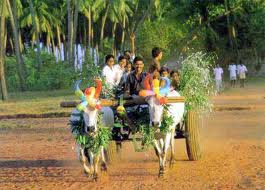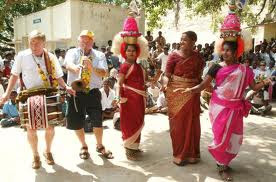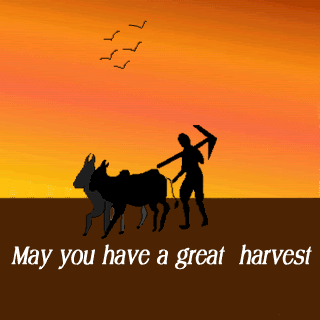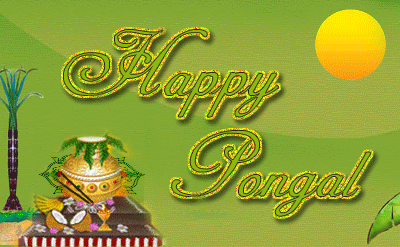Pongal Festival is Coming on 15 January 2014 and second day of Uttrayan.
About Pongal
Pongal is the only festival of Hindu that follows a solar calendar and is celebrated on the fourteenth of January every year. Pongal has astronomical significance: it marks the beginning of Uttarayana, the Sun’s movement northward for a six month period. In Hinduism, Uttarayana is considered auspicious, as opposed to Dakshinaayana, or the southern movement of the sun. All important events are scheduled during this period. Makara Sankranthi refers to the event of the Sun entering the zodiac sign of Makara or Capricorn.
In Hindu temples bells, drums, clarinets and conch shells herald the joyous occasion of Pongal. To symbolize a bountiful harvest, rice is cooked in new pots until they boil over. Some of the rituals performed in the temple include the preparation of rice, the chanting of prayers and the offering of vegetables, sugar cane and spices to the gods. Devotees then consume the offerings to exonerate themselves of past sins.
Mid-January is an important time in the Tamil calendar. The harvest festival, Pongal, falls typically on the 14th or the 15th of January and is the quintessential ‘Tamil Festival’. Pongal is a harvest festival, a traditional occasion for giving thanks to nature, for celebrating the life cycles that give us grain. Tamilians say ‘Thai pirandhaal vazhi pirakkum’, and believe that knotty family problems will be solved with the advent of the Tamil month Thai that begins on Pongal day. This is traditionally the month of weddings. This is not a surprise in a largely agricultural community – the riches gained from a good harvest form the economic basis for expensive family occasions like weddings.
The First Day
This first day is celebrated as Bhogi festival in honor of Lord Indra, the supreme ruler of clouds that give rains. Homage is paid to Lord Indra for the abundance of harvest, thereby bringing plenty and prosperity to the land. Another ritual observed on this day is Bhogi Mantalu, when useless household articles are thrown into a fire made of wood and cow-dung cakes. Girls dance around the bonfire, singing songs in praise of the gods, the spring and the harvest. The significance of the bonfire, in which is burnt the agricultural wastes and firewood is to keep warm during the last lap of winter.
The Second Day
On the second day of Pongal, the puja or act of ceremonial worship is performed when rice is boiled in milk outdoors in a earthenware pot and is then symbolically offered to the sun-god along with other oblations. All people wear traditional dress and markings, and their is an interesting ritual where husband and wife dispose off elegant ritual utensils specially used for the puja. In the village, the Pongal ceremony is carried out more simply but with the same devotion. In accordance with the appointed ritual a turmeric plant is tied around the pot in which the rice will be boiled. The offerings include the two sticks of sugar-cane in background and coconut and bananas in the dish. A common feature of the puja, in addition to the offerings, is the kolam, the auspicious design which is traditionally traced in white lime powder before the house in the early morning after bathing.
The Third Day
The third day is known as Mattu Pongal, the day of Pongal for cows. Multi-colored beads, tinkling bells, sheaves of corn and flower garlands are tied around the neck of the cattle and then are worshiped. They are fed with Pongal and taken to the village centers. The resounding of their bells attract the villagers as the young men race each other’s cattle. The entire atmosphere becomes festive and full of fun and revelry. Arati is performed on them, so as to ward off the evil eye. According to a legend, once Shiva asked his bull, Basava, to go to the earth and ask the mortals to have an oil massage and bath every day and to eat once a month. Inadvertently, Basava announced that everyone should eat daily and have an oil bath once a month. This mistake enraged Shiva who then cursed Basava, banishing him to live on the earth forever. He would have to plough the fields and help people produce more food. Thus the association of this day with cattle.
The Fourth Day
The Fourth day is known as Knau or Kannum Pongal day. On this day, a turmeric leaf is washed and is then placed on the ground. On this leaf are placed, the left overs of sweet Pongal and Venn Pongal, ordinary rice as well as rice colored red and yellow, betel leaves, betel nuts, two pieces of sugarcane, turmeric leaves, and plantains. In Tamil Nadu women perform this ritual before bathing in the morning. All the women, young and old, of the house assemble in the courtyard. The rice is placed in the centre of the leaf, while the women ask that the house and family of their brothers should prosper. Arati is performed for the brothers with turmeric water, limestone and rice, and this water is sprinkled on the kolam in front of the house.
Happy Pongal to all!
We thank sun for burning himself to save us.
We thank plants sacrificing their life for us.
And we thank all the creatures helping us to live in this world for some time.
Pongal thirunaalum,
Thalaipongal thirunalum,
Pongivarum pongal pola
Engum pongattum magizhchi
Iniya pongal nalvaazhthukkal!
Lets wake up,
Lets we all prepare for the pongal,
All member of family be there…
And say..Pongal O Pongala together..
Its day of God Sun, day to worship him
And day to see the miracle…
The virtue of God Sun,
His rays those are spectacle…
Happy Pongal to you………
May the festival of the harvest season,
Pot Rice to Sun
God Sugarcane to cow and ox
And milk to friends and family
have a happy pongal and a prosperous year ahead
Pongal Screps2014




































